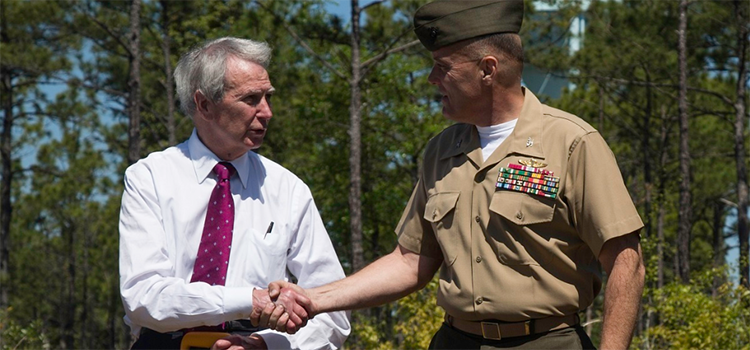The U.S. Military prides itself on serving our country in all situations, foreign and domestic. The Military coordinates with government agencies to issue out destruction to the enemies of freedom, but it also focuses on preserving this beautiful land of ours. Researchers routinely find rare or endangered species of plants and animals on bases because of the way we preserve training areas.
The cohesion between military and civilian organizations, coming together to preserve our wildlife, has grown stronger over the last decade. All branches take painstaking care to protect nature; the inheritance of generations yet to come. Here’s how:
1. The Marine Corps plants trees to save woodpeckers
In April, 2018, Col. Michael Scalise, Deputy Commander of MCI East, Camp Lejeune, met with Representative Walter Jones to plant Longleaf Pine Seedlings at Stones Creek Game Land. The Longleaf tree is a favorite of the red-cockaded woodpecker, a species that has made nests under the protection of the Marine Corps for generations. Camp Lejeune shares land with a nature preserve that further protects the woodpecker and other endangered species alike.
The ceremony of planting new trees was the culmination of state and federal conservation agencies, such as the Red-Cockaded Woodpecker Recovery and Sustainment Program partnership (RASP), to encourage the species to relocate their nesting grounds off ranges and onto safer areas. Training schedules are adjusted regularly to accommodate the woodpeckers’ preservation.

“Many years ago, [red-cockaded woodpeckers] decided to plant themselves in our training area and we decided that we wanted to help save these birds,” – Colonel Scalise
(Lip Kee)
2. The Coast Guard spearheads oil spill disasters
The Office of Marine Environmental Response Policy’s mission statement is to:
Provide guidance, policy, and tools for Coast Guard Marine Environmental Response planning, preparedness, and operations to prevent, enforce, investigate, respond to, and to mitigate the threat, frequency, and consequences of oil discharges and hazardous substance releases into the navigable waters of the United States.
They are the first line of defense against oil spills that threaten the health of our citizens and wildlife. Coast Guardsmen are the first responders in the event of a hazardous substance release polluting our waters on a very real, catastrophic scale. Coasties are the stewards of our oceans, the most precious of national treasures, and risk their lives in the name of public health, national security, and U.S. economic interests.

The Coast Guard battles the Deepwater Horizon oil spill.
3. The Army saves endangered butterflies with controlled burns
Across many Army Installations, a variety of endangered butterflies would rather take their chances living on artillery impact areas due to habitat destruction. Species such as the St. Francis Satyr need disturbance to keep their populations at a thriving level. The fires set by explosions burn across forests and wetlands that benefit the frail little ones. Even if an impact kills some butterflies, even more are able to take their place. At least three of the world’s rarest butterflies have found safety among the howitzer shells of Fort Bragg, NC.
The Army partners with biologists to retrieve females and relocate them to a greenhouse the Army built. The butterflies are bred and released into new areas for the population to continue to grow. Biologists and the Army recreate zones that resemble the impact areas to ensure the population won’t have to resort to living amongst unexploded ordinance.
Other species, such as the one in the video below, also call Army bases home.
4. The Air Force prevents the contamination of wildlife after training
The Air Force has a division that specializes in Restoration Systems and Strategies. Their mission is to promote efficient and effective restoration of contaminated sites. They provide expertise on clean-up exit strategies and implementation of effective remediation using science and engineering. They ensure that the Air Force keeps up with their environmental responsibilities and tracks progress to prevent adverse long-term effects of training.
Performance-based remediation has become the standard for the Environmental Restoration Technical Support Branch that keeps the homes of wildlife clean.

It’s as if the military was never here…
(USAF Civil Engineer Center)
5. The Navy shares their data with marine researchers
The Navy has a program called Marine Species Research and Monitoring and has invested over $300 million dollars to better understand marine species and the location of important habitat areas. Civilian researchers have access to the Navy’s data about the migratory patterns of whales, sea turtles, and birds that can aid them when their work is peer-reviewed.
The benefit is mutually beneficial because the published works can then be used by the Navy to develop tools to better estimate the potential effects of underwater sound. The program empowers scientists with research they otherwise would never have had access to independently, and the Navy can safeguard marine protected species.
This article originally appeared on We Are The Mighty
Malaria Candidate Vaccine Proves Effective
Force Recon Marines Use This Risky Tactic To Sneak Behind Enemy Lines
The Long Blue Line: Coast Guard Combat Operations
Follow We Are The Mighty on Twitter
READ NEXT: VETERANS IN THE ENERGY INDUSTRY
READ NEXT: CHANGE THE WORLD: BECOME AN ENVIRONMENTAL SCIENTIST
READ NEXT: CAREERS FOR VETERANS IN THE LIFE SCIENCE AND MEDICAL FIELD









